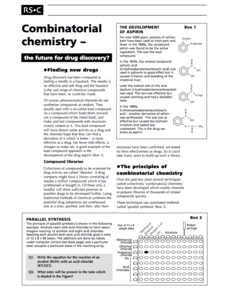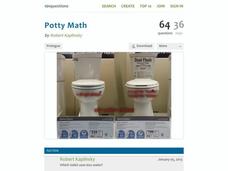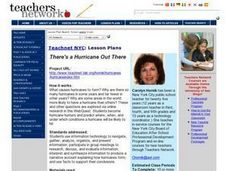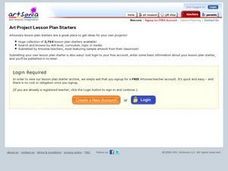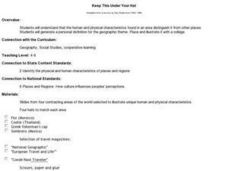Scholastic
Marijuana Facts
Can marijuana really hurt you? Three medical facts and three discussion questions prompt teenagers to consider the ramifications of using marijuana recreationally.
Discovery Education
It's Melting!
It's a race to the finish! Which ice cube will melt the fastest? Scholars discover the effect thermal energy has on melting ice. They experiment with melting ice cubes on different materials and learn that even at a consistent...
American Museum of Natural History
Welcome to the Dzanga-Sangha
One ecosystem is home to numerous habitats—how diverse are they? Pupils interact with an online lesson to explore three habitats in a rain forest ecosystem. They discover connections between species and how they depend on each other for...
NOAA
Ocean Geologic Features
Sediment samples from the ocean bottoms tell scientists about climate change, pollution, and changes in erosion for the area. Groups of learners focus on sediments and their movement through water. During a hands-on activity, they...
Royal Society of Chemistry
Combinatorial Chemistry—Chemistry Now
Finding new drugs has been likened to finding a needle in a haystack. How do pharmaceutical companies do it? One of a small series of four informative leaflets examines combinatorial chemistry, the method at the forefront of new drug...
National Nanotechnology Infrastructure Network
Jell-O® Waveguide and Power Loss
Jell-O® can help model the transmission of light through fiber optic cables. Young scientists use the jiggly dessert to make a waveguide to transmit a laser beam from one point to another. Their models help them learn the function...
Reed Novel Studies
A Single Shard: Novel Study
Fulfilling a dream requires a lot of hard work. A study guide for the novel A Single Shard shares the dream of a young Korean orphan. As readers work through the guide, they answer comprehension questions about Tree-ear and the...
National Weather Service
The Water Cycle
Looking for a full-color, labeled water cycle diagram? You found one! From evaporation to precipitation to plant uptake and everything in between, it's all here and beautifully illustrated.
Code.org
Good and Bad Data Visualizations
Good versus bad data. Pairs rate online collections of data representations from good to bad and then suggest ways to improve the visualizations. The class then creates a list of best practices and common errors in data representations...
101 Questions
Potty Math
You don't want to flush your money down the drain! Have your classes complete a financial comparison between two different types of toilets. They use linear modeling to determine the most cost-effective model.
Nuffield Foundation
Microbes Ate My Homework
Now you have a new excuse not to do your homework. A long-term experiment has learners explore cellulose-digesting enzymes. They simulate how paper breaks down in a compost bin. There's no need to blame your dog for eating your homework...
Country Music Hall of Fame
Ray Charles and Country Music
Ray Charles used the pain and adversity from his life to influence an entire genre of American music. Learn about the musician's daily life, struggles and success, and powerful musical style with a thorough resource.
Curated OER
Worry Dolls
First graders are read The Worrywarts, by Pamela Duncan Edwards. In this discussing your worries lesson plan, 1st graders listen to the story and have a class discussion about how they handle their worries. They are introduced to "worry...
Curated OER
It's All in the Spice
Students explore different spices that come from all over the world. Students discover names of certain spices they might not have been aware of. Students learn where certain spices originated and they discuss what the world would be...
Curated OER
Living and Non-Living
Students discover the basic needs of life. In this science lesson plan, students explore how all living things need air, water, food and shelter
Curated OER
Shadow Pictures
Learners discover the power of lights, shades, and shadows in this Art lesson intended for upper-elementary/middle-level Art classrooms. Older students may want to experiment by adding more than one silhouette to the Bristol board used...
Curated OER
Around the World with Bud the Sub
First graders review the recently taught vowel /o/. They then form the sound for /u/ telling whether it is a closed or open vowel sound and repeat it several times together. They practice a /u/ tongue twister saying it together and...
Curated OER
History of World Religions
First graders listen to a variety of Noah's Ark, based on the story in the Old Testament. They hear another "flood story" for comparison.
Curated OER
There's a Hurricane Out There
Students use information technology to conduct research. They become hurricane hunters and predict where, when, and under which conditions a hurricane will be likely to hit.
Curated OER
Teach and Learn: Journalism
Students read and discuss keypoints of the article, "Iceland to start hunting whales." They write in the style of newspaper reporters and order the information so that it tells the story from beginning to end with relevant detail
Curated OER
Our Tangible World is Full of Dimensions
Sixth graders explore characteristics of two and three-dimensional figures. They observe the teacher demonstrate the faces, edges, vertices and names of specific figures. In groups, 6th graders examine and describe given figures. ...
Curated OER
It's A Jungle Out There!
Students report on an animal according to its appearance, habitat, and characteristics.
Curated OER
Keep This Under Your Hat
Students identify and describe the human and physical characteristics of various geographical areas. In groups, they wear a hat to represent that region and view slides on how they are worn. They create a collage using magazine pictures...
Curated OER
Magnetic Discovery Bottle
Students examine how to conduct simple investigations and use simple equipment to gather data. For this magnet lesson students decide what types of objects are attracted to magnets.




